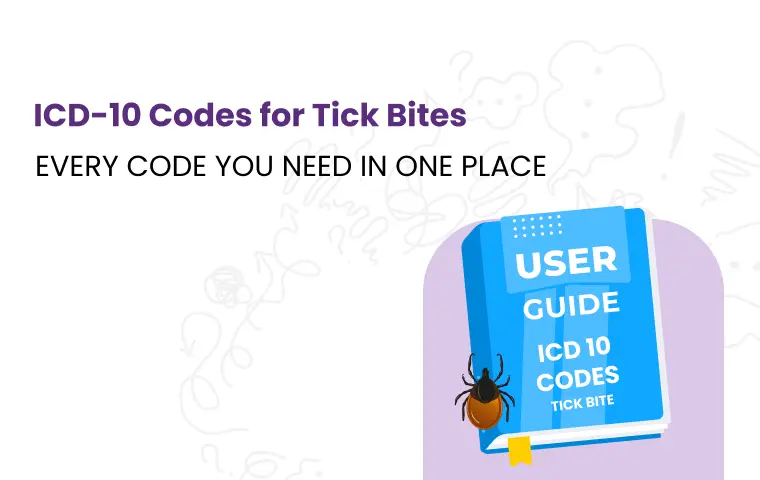You’re reviewing a patient’s chart after treating a tick bite, but when it comes time to enter the ICD-10 code, you pause. Was the bite venomous or non-venomous? Where exactly was the bite located? Each of these details requires a different code, and getting it wrong could complicate billing and reimbursement.
That’s why we’ve put together this all-encompassing guide to ICD-10 codes for tick bites. With everything in one place, you’ll be able to quickly and accurately select the correct code, ensuring smooth billing processes and proper documentation every time.
How Is a Tick Bite Coded?
When coding a tick bite, you might think it's as simple as selecting a straightforward code, but the reality is a bit more complex. Unlike some other insect bites, coding for a tick bite requires using two diagnosis codes to accurately capture the event.
First, you must select a code from the injury chapter that describes explicitly the injury and its location. This ensures that the medical record accurately reflects the site of the tick bite—whether it’s on the arm, leg, or another part of the body.
But that’s not all. You must also assign a second code from the external cause chapter, which details how the injury occurred. This code provides context, indicating that a tick bite caused the injury.
What is the Billable ICD 10 Code For Tick Bite?
The billable ICD-10 code for a tick bite is W57.XXXA. This code represents "Bitten or stung by nonvenomous insect and other nonvenomous arthropods, initial encounter."
If the encounter is subsequent or for a sequela (a condition that is the consequence of a previous disease or injury), you would use:
-
W57.XXXD for a subsequent encounter
-
W57.XXXS for sequela
Can you submit W57.xxxA in the First Position?
A common mistake that many providers make is placing the external cause code W57.XXXA in the first position. While W57.XXXA accurately describes being bitten or stung by a nonvenomous insect (such as a tick), it is, in fact, an external cause code. As such, it should never be submitted in the first position.
External cause codes like W57.XXXA are used to provide additional context about the injury—specifically, how it happened. However, these codes are supplementary. They describe the external circumstances of an injury but don't capture the injury itself. This is why ICD-10 guidelines mandate that an external cause code cannot be the primary code on a claim form.
To accurately reflect a tick bite, your primary code should describe the injury's specific nature and location. The "S" code should be placed in the first position on your claim form. It directly addresses the injury or condition resulting from the tick bite, which is essential for correct billing and documentation.
ICD 10 Code Tree For Insect Bite
Now, let's dive into the ICD-10 codes used to document insect bites on any part of the body. We'll explore the specific codes that describe the location of the bite, from the upper arm to the lower leg, ensuring you have a clear understanding of how to accurately code for these encounters in your medical records.
Thorax
When documenting insect bites on the thorax, the ICD-10 coding provides specific codes depending on whether the bite is located on the front or back wall of the thorax.
Front Wall of Thorax
For insect bites on the front wall of the thorax, the ICD-10 codes are categorized based on the exact location:
-
S20.361: Insect bite (nonvenomous) of the right front wall of the thorax
-
S20.362: Insect bite (nonvenomous) of the left front wall of the thorax
-
S20.363: Insect bite (nonvenomous) of the bilateral front wall of the thorax
-
S20.364: Insect bite (nonvenomous) of the middle front wall of the thorax
-
S20.369: Insect bite (nonvenomous) of the unspecified front wall of the thorax
These codes allow you to specify the precise location of the insect bite on the front wall of the thorax, enhancing the accuracy of your records.
Back Wall of Thorax
Similarly, for bites on the back wall of the thorax, the codes vary based on the location:
-
S20.461: Insect bite (nonvenomous) of the right back wall of the thorax
-
S20.462: Insect bite (nonvenomous) of the left back wall of the thorax
-
S20.469: Insect bite (nonvenomous) of the unspecified back wall of the thorax
These codes ensure that you can accurately document the site of the insect bite on the back wall of the thorax, whether it’s on the right, left, or an unspecified location.
Head
Next, let's focus on documenting insect bites that occur on the head, specifically the scalp. The ICD-10 code S00.06 is used to describe nonvenomous insect bites in this area. Depending on the type of encounter, here are the specific codes you should use:
-
S00.06XA: Insect bite (nonvenomous) of scalp, initial encounter
-
S00.06XD: Insect bite (nonvenomous) of scalp, subsequent encounter
-
S00.06XS: Insect bite (nonvenomous) of scalp, sequela
Nose
When documenting an insect bite on the nose, the appropriate ICD-10 code is S00.36. This code is used to indicate a nonvenomous insect bite specifically located on the nose. The codes are further specified based on the type of encounter:
-
S00.36XA: Insect bite (nonvenomous) of nose, initial encounter
-
S00.36XD: Insect bite (nonvenomous) of nose, subsequent encounter
-
S00.36XS: Insect bite (nonvenomous) of nose, sequela
Ear
When it comes to recording a nonvenomous insect bite on the ear, the ICD-10 code S00.46 is the one you'll need. This code is crucial for ensuring that the location and nature of the injury are accurately reflected in the patient's medical records.
For different stages of care related to an insect bite on the ear, the code is modified as follows:
-
S00.46XA: Used when the patient is seen for the initial encounter regarding the insect bite.
-
S00.46XD: Applied during subsequent visits, reflecting ongoing treatment or follow-up care.
-
S00.46XS: Utilized when documenting a sequela, indicating any lingering effects or complications from the initial bite.
Neck
When an insect bite occurs on the neck, it's important to use the correct ICD-10 code to reflect the specific area affected. The code S10.16 is designated for nonvenomous insect bites on the throat. This ensures that the injury is accurately categorized based on the location.
Here’s how the code is used in different clinical scenarios:
-
S10.16XA: This code applies to the initial medical encounter, documenting the first time the patient is treated for the insect bite on the neck.
-
S10.16XD: Use this code for follow-up visits, where the patient returns for further treatment or assessment of the bite.
-
S10.16XS: This code is utilized when dealing with sequela, indicating any ongoing issues or complications arising from the initial insect bite.
Abdomen, Lower Back, Pelvis, and External Genitals
When documenting nonvenomous insect bites in areas such as the abdomen, lower back, pelvis, and external genitals, the ICD-10 code S30.86 and its subcategories provide detailed options based on the specific location of the bite. Here's a breakdown of how these codes are applied:
-
S30.860: This code is used for insect bites on the lower back and pelvis, capturing the injury within this general region.
-
S30.861: When the insect bite is located on the abdominal wall, this specific code should be used.
-
S30.862: For insect bites on the penis, this code precisely indicates the site of the bite.
-
S30.863: Use this code to document bites on the scrotum and testes, ensuring the specific external male genital area is noted.
-
S30.864: This code applies to insect bites on the vagina and vulva, covering the external female genital organs.
-
S30.865: When the bite is on unspecified external genital organs (male), this code is appropriate.
-
S30.866: Similarly, use this code for bites on unspecified external genital organs (female).
-
S30.867: For insect bites on the anus, this code provides the necessary specificity.
Shoulders & Arms
In cases where a nonvenomous insect bite affects the shoulder or upper arm, the ICD-10 codes offer a range of options to specify the exact location of the bite. This ensures that every detail is captured, from which shoulder is affected to whether the bite is on the right or left upper arm.
For bites on the shoulder, the coding options include:
-
S40.261: Used when the insect bite is on the right shoulder.
-
S40.262: Applied for bites on the left shoulder.
-
S40.263: Covers situations where the bite is on the shoulder but not further specified.
When the upper arm is involved, the coding options allow for even more detailed documentation:
-
S40.861: Specifically for insect bites on the right upper arm.
-
S40.862: For bites on the left upper arm.
-
S40.869: Used when the exact upper arm is unspecified.
Final Words
The proper use of ICD-10 codes for documenting tick bites is critical in maintaining the accuracy and integrity of medical records. By carefully selecting the appropriate codes that reflect the precise location and stage of treatment, healthcare providers ensure that patient care is well-documented and that billing processes are aligned with regulatory standards. This level of detail supports effective treatment planning and contributes to the overall efficiency of healthcare delivery.
ABOUT AUTHOR

John Wick
As a blog writer with years of experience in the healthcare industry, I have got what it takes to write well-researched content that adds value for the audience. I am a curious individual by nature, driven by passion and I translate that into my writings. I aspire to be among the leading content writers in the world.
